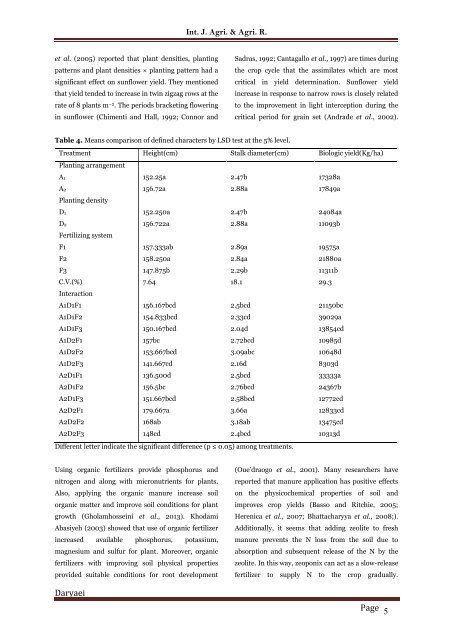Effect of planting pattern, plant density and integration of zeoponix and chemical fertilizer (urea) on sunflower yield and yield components
An experiment was conducted to evaluate the effect of planting pattern, plant density and integration of zeoponix and chemical N fertilizer (urea) on sunflower yield and yield components. The experimental design was analyzed as factorial based on randomized complete block with three replications. Treatments consisted of 3 factors which are different crop densities, including 2 levels. The population of plants was including 5 plants m–2 (d1) and 8 plants m–2 (d2). The second factor was planting patterns which were included twin rectangular rows (A1) and twin zigzag rows (A2). Different fertilizing treatments were selected as third factor consisted of the sole application of zeoponix (f1) and chemical fertilizer urea (f3), and integration of 50%zeoponix +50% chemical fertilizer urea (f2), that were at 3 levels. Results showed that there were significant differences in interaction of planting pattern, plant density and fertilizing system on plant height, stalk diameter, biologic yield, seed yield, number of seeds per head, 1000 seed weight, seed oil content and oil yield, protein content and protein yield and harvest index. LSD test for means of these traits showed that zigzag arrangement × plant population of 8 plants m–2 × 100% zeoponix (a2d2f1) treatment had the best performance and could be recommended to farmers for sunflower cultivation. Get the full articles at: http://www.innspub.net/volume-7-number-6-december-2015-ijaar/
An experiment was conducted to evaluate the effect of planting pattern, plant density and integration of zeoponix and chemical N fertilizer (urea) on sunflower yield and yield components. The experimental design was analyzed as factorial based on randomized complete block with three replications. Treatments consisted of 3 factors which are different crop densities, including 2 levels. The population of plants was including 5 plants m–2 (d1) and 8 plants m–2 (d2). The second factor was planting patterns which were included twin rectangular rows (A1) and twin zigzag rows (A2). Different fertilizing treatments were selected as third factor consisted of the sole application of zeoponix (f1) and chemical fertilizer urea (f3), and integration of 50%zeoponix +50% chemical fertilizer urea (f2), that were at 3 levels. Results showed that there were significant differences in interaction of planting pattern, plant density and fertilizing system on plant height, stalk diameter, biologic yield, seed yield, number of seeds per head, 1000 seed weight, seed oil content and oil yield, protein content and protein yield and harvest index. LSD test for means of these traits showed that zigzag arrangement × plant population of 8 plants m–2 × 100% zeoponix (a2d2f1) treatment had the best performance and could be recommended to farmers for sunflower cultivation. Get the full articles at: http://www.innspub.net/volume-7-number-6-december-2015-ijaar/
You also want an ePaper? Increase the reach of your titles
YUMPU automatically turns print PDFs into web optimized ePapers that Google loves.
Int. J. Agri. & Agri. R.<br />
et al. (2005) reported that <str<strong>on</strong>g>plant</str<strong>on</strong>g> densities, <str<strong>on</strong>g><str<strong>on</strong>g>plant</str<strong>on</strong>g>ing</str<strong>on</strong>g><br />
<str<strong>on</strong>g>pattern</str<strong>on</strong>g>s <str<strong>on</strong>g>and</str<strong>on</strong>g> <str<strong>on</strong>g>plant</str<strong>on</strong>g> densities × <str<strong>on</strong>g><str<strong>on</strong>g>plant</str<strong>on</strong>g>ing</str<strong>on</strong>g> <str<strong>on</strong>g>pattern</str<strong>on</strong>g> had a<br />
significant effect <strong>on</strong> <strong>sunflower</strong> <strong>yield</strong>. They menti<strong>on</strong>ed<br />
that <strong>yield</strong> tended to increase in twin zigzag rows at the<br />
rate <str<strong>on</strong>g>of</str<strong>on</strong>g> 8 <str<strong>on</strong>g>plant</str<strong>on</strong>g>s m –2 . The periods bracketing flowering<br />
in <strong>sunflower</strong> (Chimenti <str<strong>on</strong>g>and</str<strong>on</strong>g> Hall, 1992; C<strong>on</strong>nor <str<strong>on</strong>g>and</str<strong>on</strong>g><br />
Sadras, 1992; Cantagallo et al., 1997) are times during<br />
the crop cycle that the assimilates which are most<br />
critical in <strong>yield</strong> determinati<strong>on</strong>. Sunflower <strong>yield</strong><br />
increase in resp<strong>on</strong>se to narrow rows is closely related<br />
to the improvement in light intercepti<strong>on</strong> during the<br />
critical period for grain set (Andrade et al., 2002).<br />
Table 4. Means comparis<strong>on</strong> <str<strong>on</strong>g>of</str<strong>on</strong>g> defined characters by LSD test at the 5% level.<br />
Treatment Height(cm) Stalk diameter(cm) Biologic <strong>yield</strong>(Kg/ha)<br />
Planting arrangement<br />
A1 152.25a 2.47b 17328a<br />
A2 156.72a 2.88a 17849a<br />
Planting <str<strong>on</strong>g>density</str<strong>on</strong>g><br />
D1 152.250a 2.47b 24084a<br />
D2 156.722a 2.88a 11093b<br />
Fertilizing system<br />
F1 157.333ab 2.89a 19575a<br />
F2 158.250a 2.84a 21880a<br />
F3 147.875b 2.29b 11311b<br />
C.V.(%) 7.64 18.1 29.3<br />
Interacti<strong>on</strong><br />
A1D1F1 156.167bcd 2.5bcd 21150bc<br />
A1D1F2 154.833bcd 2.33cd 39029a<br />
A1D1F3 150.167bcd 2.04d 13854cd<br />
A1D2F1 157bc 2.72bcd 10985d<br />
A1D2F2 153.667bcd 3.09abc 10648d<br />
A1D2F3 141.667cd 2.16d 8303d<br />
A2D1F1 136.500d 2.5bcd 33333a<br />
A2D1F2 156.5bc 2.76bcd 24367b<br />
A2D1F3 151.667bcd 2.58bcd 12772cd<br />
A2D2F1 179.667a 3.66a 12833cd<br />
A2D2F2 168ab 3.18ab 13475cd<br />
A2D2F3 148cd 2.4bcd 10313d<br />
Different letter indicate the significant difference (p ≤ 0.05) am<strong>on</strong>g treatments.<br />
Using organic <str<strong>on</strong>g>fertilizer</str<strong>on</strong>g>s provide phosphorus <str<strong>on</strong>g>and</str<strong>on</strong>g><br />
nitrogen <str<strong>on</strong>g>and</str<strong>on</strong>g> al<strong>on</strong>g with micr<strong>on</strong>utrients for <str<strong>on</strong>g>plant</str<strong>on</strong>g>s.<br />
Also, applying the organic manure increase soil<br />
organic matter <str<strong>on</strong>g>and</str<strong>on</strong>g> improve soil c<strong>on</strong>diti<strong>on</strong>s for <str<strong>on</strong>g>plant</str<strong>on</strong>g><br />
growth (Gholamhosseini et al., 2013). Khodami<br />
Abasiyeh (2003) showed that use <str<strong>on</strong>g>of</str<strong>on</strong>g> organic <str<strong>on</strong>g>fertilizer</str<strong>on</strong>g><br />
increased available phosphorus, potassium,<br />
magnesium <str<strong>on</strong>g>and</str<strong>on</strong>g> sulfur for <str<strong>on</strong>g>plant</str<strong>on</strong>g>. Moreover, organic<br />
<str<strong>on</strong>g>fertilizer</str<strong>on</strong>g>s with improving soil physical properties<br />
provided suitable c<strong>on</strong>diti<strong>on</strong>s for root development<br />
(Oue’draogo et al., 2001). Many researchers have<br />
reported that manure applicati<strong>on</strong> has positive effects<br />
<strong>on</strong> the physico<str<strong>on</strong>g>chemical</str<strong>on</strong>g> properties <str<strong>on</strong>g>of</str<strong>on</strong>g> soil <str<strong>on</strong>g>and</str<strong>on</strong>g><br />
improves crop <strong>yield</strong>s (Basso <str<strong>on</strong>g>and</str<strong>on</strong>g> Ritchie, 2005;<br />
Herenica et al., 2007; Bhattacharyya et al., 2008;).<br />
Additi<strong>on</strong>ally, it seems that adding zeolite to fresh<br />
manure prevents the N loss from the soil due to<br />
absorpti<strong>on</strong> <str<strong>on</strong>g>and</str<strong>on</strong>g> subsequent release <str<strong>on</strong>g>of</str<strong>on</strong>g> the N by the<br />
zeolite. In this way, <str<strong>on</strong>g>zeop<strong>on</strong>ix</str<strong>on</strong>g> can act as a slow-release<br />
<str<strong>on</strong>g>fertilizer</str<strong>on</strong>g> to supply N to the crop gradually.<br />
Daryaei<br />
Page 5


















